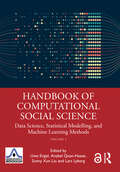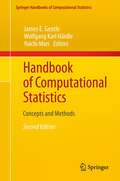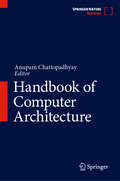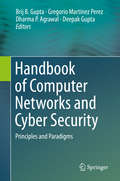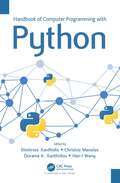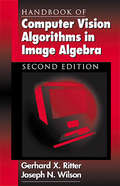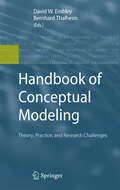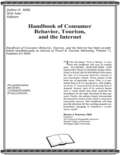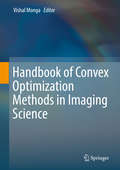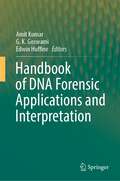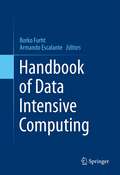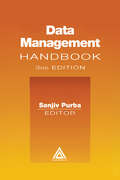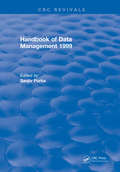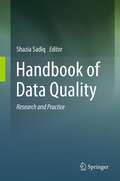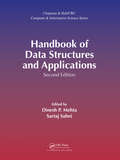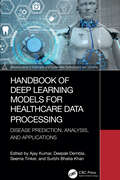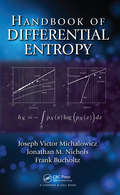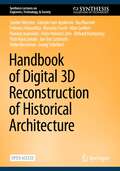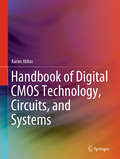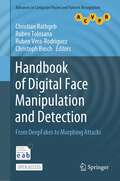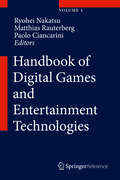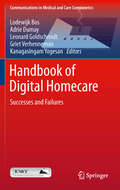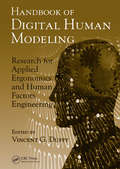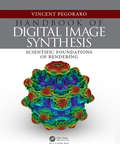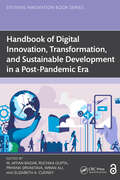- Table View
- List View
Handbook of Computational Social Science, Volume 2: Data Science, Statistical Modelling, and Machine Learning Methods (European Association of Methodology Series)
by Lars Lyberg Uwe Engel Anabel Quan-Haase Sunny Xun LiuThe Handbook of Computational Social Science is a comprehensive reference source for scholars across multiple disciplines. It outlines key debates in the field, showcasing novel statistical modeling and machine learning methods, and draws from specific case studies to demonstrate the opportunities and challenges in CSS approaches. The Handbook is divided into two volumes written by outstanding, internationally renowned scholars in the field. This second volume focuses on foundations and advances in data science, statistical modeling, and machine learning. It covers a range of key issues, including the management of big data in terms of record linkage, streaming, and missing data. Machine learning, agent-based and statistical modeling, as well as data quality in relation to digital trace and textual data, as well as probability, non-probability, and crowdsourced samples represent further foci. The volume not only makes major contributions to the consolidation of this growing research field, but also encourages growth into new directions. With its broad coverage of perspectives (theoretical, methodological, computational), international scope, and interdisciplinary approach, this important resource is integral reading for advanced undergraduates, postgraduates, and researchers engaging with computational methods across the social sciences, as well as those within the scientific and engineering sectors.
Handbook of Computational Statistics
by Wolfgang Karl Härdle James E. Gentle Yuichi MoriThe Handbook of Computational Statistics - Concepts and Methods (second edition) is a revision of the first edition published in 2004, and contains additional comments and updated information on the existing chapters, as well as three new chapters addressing recent work in the field of computational statistics. This new edition is divided into 4 parts in the same way as the first edition. It begins with "How Computational Statistics became the backbone of modern data science" (Ch.1): an overview of the field of Computational Statistics, how it emerged as a separate discipline, and how its own development mirrored that of hardware and software, including a discussion of current active research. The second part (Chs. 2 - 15) presents several topics in the supporting field of statistical computing. Emphasis is placed on the need for fast and accurate numerical algorithms, and some of the basic methodologies for transformation, database handling, high-dimensional data and graphics treatment are discussed. The third part (Chs. 16 - 33) focuses on statistical methodology. Special attention is given to smoothing, iterative procedures, simulation and visualization of multivariate data. Lastly, a set of selected applications (Chs. 34 - 38) like Bioinformatics, Medical Imaging, Finance, Econometrics and Network Intrusion Detection highlight the usefulness of computational statistics in real-world applications.
Handbook of Computer Architecture
by Anupam ChattopadhyayThis handbook presents the key topics in the area of computer architecture covering from the basic to the most advanced topics, including software and hardware design methodologies. It will provide readers with the most comprehensive updated reference information covering applications in single core processors, multicore processors, application-specific processors, reconfigurable architectures, emerging computing architectures, processor design and programming flows, test and verification. This information benefits the readers as a full and quick technical reference with a high-level review of computer architecture technology, detailed technical descriptions and the latest practical applications.
Handbook of Computer Networks and Cyber Security: Principles and Paradigms
by Gregorio Martinez Perez Deepak Gupta Brij B. Gupta Dharma P. AgrawalThis handbook introduces the basic principles and fundamentals of cyber security towards establishing an understanding of how to protect computers from hackers and adversaries. The highly informative subject matter of this handbook, includes various concepts, models, and terminologies along with examples and illustrations to demonstrate substantial technical details of the field. It motivates the readers to exercise better protection and defense mechanisms to deal with attackers and mitigate the situation. This handbook also outlines some of the exciting areas of future research where the existing approaches can be implemented.Exponential increase in the use of computers as a means of storing and retrieving security-intensive information, requires placement of adequate security measures to safeguard the entire computing and communication scenario. With the advent of Internet and its underlying technologies, information security aspects are becoming a prime concern towards protecting the networks and the cyber ecosystem from variety of threats, which is illustrated in this handbook.This handbook primarily targets professionals in security, privacy and trust to use and improve the reliability of businesses in a distributed manner, as well as computer scientists and software developers, who are seeking to carry out research and develop software in information and cyber security. Researchers and advanced-level students in computer science will also benefit from this reference.
Handbook of Computer Programming with Python
by Dimitrios XanthidisThis handbook provides a hands-on experience based on the underlying topics, and assists students and faculty members in developing their algorithmic thought process and programs for given computational problems. It can also be used by professionals who possess the necessary theoretical and computational thinking background but are presently making their transition to Python. Key Features: • Discusses concepts such as basic programming principles, OOP principles, database programming, GUI programming, application development, data analytics and visualization, statistical analysis, virtual reality, data structures and algorithms, machine learning, and deep learning. • Provides the code and the output for all the concepts discussed. • Includes a case study at the end of each chapter. This handbook will benefit students of computer science, information systems, and information technology, or anyone who is involved in computer programming (entry-to-intermediate level), data analytics, HCI-GUI, and related disciplines.
Handbook of Computer Vision Algorithms in Image Algebra
by Joseph N. Wilson Gerhard X. RitterImage algebra is a comprehensive, unifying theory of image transformations, image analysis, and image understanding. In 1996, the bestselling first edition of the Handbook of Computer Vision Algorithms in Image Algebra introduced engineers, scientists, and students to this powerful tool, its basic concepts, and its use in the concise representation
Handbook of Conceptual Modeling
by Bernhard Thalheim David W. EmbleyThe Handbook of Conceptual Modeling collects many of the best conceptual-modeling ideas, techniques, and practices as well as the challenges that drive research in the field. It points toward interesting challenges.
Handbook of Consumer Behavior, Tourism, and the Internet
by Juline Mills Rob LawMake the most of your online business resources The growing acceptance and use of the Internet as an increasingly valuable travel tool has tourism and hospitality businesses taking a critical look at their business-to-customer online environments while pondering such questions as, "How do I get people to visit my Web site?" "Is my Web site attracting the &’right&’ kind of e-consumers?" and "How do I turn browsers into buyers?" The Handbook of Consumer Behavior, Tourism, and the Internet analyzes the latest strategies involving Internet business applications that will help you attract-and keep-online travel customers. Researchers from the United States, Europe, and Asia present the latest findings you need to make the right decisions regarding long-term e-commerce development and planning.The Handbook of Consumer Behavior, Tourism, and the Internet examines vital issues affecting the travel and tourism industry from an online perspective. This book analyzes the latest theory and research on general online buyer characteristics, the differences between online and offline consumer behavior, the differences between broadband and narrowband users, the online search process, quality and perception of lodging brands, and Web site design, maintenance, and development. Each section of the book includes a model/diagram that serves as an overview of the topic, followed by a thorough discussion on the topic from several sources. Each section ends with commentary on the areas where future research is needed. The book&’s contributors use a variety of research methodologies ranging from qualitative data analyses using artificial neutral network analysis, to experimental design, non-parametric statistical tests, and structural equation modeling. Topics examined in the Handbook of Consumer Behavior, Tourism, and the Internet include: the need for businesses to use internal examinations to determine and meet online consumer needs the emerging field of e-complaint behavior-consumers taking to the Web to voice complaints about travel services how to use e-tools to measure guest satisfaction how to measure consumer reaction to Web-based technology the Internet&’s impact on decision making for travel products and how to use e-mail marketing, electronic customer relationship management (eCRM), Web positioning, and search engine placementThe Handbook of Consumer Behavior, Tourism, and the Internet is equally valuable as a classroom resource or professional reference, providing up-to-date material on Internet applications and their impact on consumers and e-commerce.
Handbook of Convex Optimization Methods in Imaging Science
by Vishal MongaThis book covers recent advances in image processing and imaging sciences from an optimization viewpoint, especially convex optimization with the goal of designing tractable algorithms. Throughout the handbook, the authors introduce topics on the most key aspects of image acquisition and processing that are based on the formulation and solution of novel optimization problems. The first part includes a review of the mathematical methods and foundations required, and covers topics in image quality optimization and assessment. The second part of the book discusses concepts in image formation and capture from color imaging to radar and multispectral imaging. The third part focuses on sparsity constrained optimization in image processing and vision and includes inverse problems such as image restoration and de-noising, image classification and recognition and learning-based problems pertinent to image understanding. Throughout, convex optimization techniques are shown to be a critically important mathematical tool for imaging science problems and applied extensively. Convex Optimization Methods in Imaging Science is the first book of its kind and will appeal to undergraduate and graduate students, industrial researchers and engineers and those generally interested in computational aspects of modern, real-world imaging and image processing problems.
Handbook of DNA Forensic Applications and Interpretation
by Amit Kumar G. K. Goswami Edwin HuffineThis handbook covers tested and proven DNA forensic testing methodologies, forensic bioinformatics techniques, case studies and current forensic legal framework for investigation of variety of crimes and provides a clinching evidence for speedy justice. DNA testing is widely used for forensic purposes and is changing the paradigm of (crime) investigation. The book contains chapters on usage of ultramodern DNA collection kits, presents era evidence collection and preservation, high-end DNA sample analysis in laboratory, DNA legislation, expert evidences, challenging and successful case studies, data generation and application of AI and IoT techniques for DNA data analysis, DNA databanks and training manpower to facilitate timely reporting to the requesting agencies. This handbook equips and enables police, investigators and crime analysis laboratories with knowhow of high-end tools, procedures and techniques to link or exclude a criminal to a crime. It is expected that this will be used by first responders, police, forensic analysts, judiciaries, evidence handlers and students and scholars of criminology and forensic sciences worldwide. The intention to write this handbook is to make DNA technology and its importance reach every common man and professional for correctly using it as a tool as and when required. This is quite evident that awareness of DNA technology has increased at a reasonable pace. Courts and investigating agencies are convinced and confident with its accuracy, reliability and unmatched peace delivered by various techniques of DNA fingerprinting and DNA profiling.
Handbook of Data Intensive Computing
by Borko Furht Armando EscalanteData Intensive Computing refers to capturing, managing, analyzing, and understanding data at volumes and rates that push the frontiers of current technologies. The challenge of data intensive computing is to provide the hardware architectures and related software systems and techniques which are capable of transforming ultra-large data into valuable knowledge. Handbook of Data Intensive Computing is written by leading international experts in the field. Experts from academia, research laboratories and private industry address both theory and application. Data intensive computing demands a fundamentally different set of principles than mainstream computing. Data-intensive applications typically are well suited for large-scale parallelism over the data and also require an extremely high degree of fault-tolerance, reliability, and availability. Real-world examples are provided throughout the book. Handbook of Data Intensive Computing is designed as a reference for practitioners and researchers, including programmers, computer and system infrastructure designers, and developers. This book can also be beneficial for business managers, entrepreneurs, and investors.
Handbook of Data Management1999 Edition: 1999 Edition
by Sanjiv PurbaWritten by leading industry experts, the Data Management Handbook is a comprehensive, single-volume guide to the most innovative ideas on how to plan, develop, and run a powerful data management function - as well as handle day-to-day operations. The book provides practical, hands-on guidance on the strategic, tactical, and technical aspects of dat
Handbook of Data Management: 1999 Edition
by Sanjiv PurbaPacked with dozens of no-nonsense chapters written by leading professionals, Handbook of Data Management, 1999 Edition shows your students how to design, build, and maintain high-performance, high-availability databases in multiple environments. Handbook of Data Management, 1999 Edition is the most comprehensive, single-volume guide of its kind. The book provides the latest, most innovative solutions for planning, developing, and running a powerful data management function. Here students will find exhaustive coverage of the range of data repositories (from legacy indexed files to object data bases and data warehouses) as well as details on everything from strategic planning to maximizing database performance. Completely revised and updated to reflect latebreaking technologies, Handbook of Data Management, 1999 Edition includes extensive case studies and straightforward descriptions showing students how to:implement Web-enabled data warehousesbuild multimedia databasesmaster data mininguse enterprise database modelingstay up-to-date with data conversion and migrationmaximize OLAP architectures and toolsHandbook of Data Management, 1999 Edition also provides ongoing coverage of the latest tools and techniques regarding:organization for quality information systemsdata definitiondatabase design and managementobject and hybrid databasesand moreEach contributor to Handbook of Data Management, 1999 Edition is an expert with first-hand experience in database and data management. These contributors provide a depth and breadth of coverage you and your students simply won't find anywhere else.Prepare your students for "real-world" business computing. Start them off with Handbook of Data Management, 1999 Edition.
Handbook of Data Quality: Research and Practice
by Shazia SadiqThe issue of data quality is as old as data itself. However, the proliferation of diverse, large-scale and often publically available data on the Web has increased the risk of poor data quality and misleading data interpretations. On the other hand, data is now exposed at a much more strategic level e.g. through business intelligence systems, increasing manifold the stakes involved for individuals, corporations as well as government agencies. There, the lack of knowledge about data accuracy, currency or completeness can have erroneous and even catastrophic results. With these changes, traditional approaches to data management in general, and data quality control specifically, are challenged. There is an evident need to incorporate data quality considerations into the whole data cycle, encompassing managerial/governance as well as technical aspects. Data quality experts from research and industry agree that a unified framework for data quality management should bring together organizational, architectural and computational approaches. Accordingly, Sadiq structured this handbook in four parts: Part I is on organizational solutions, i.e. the development of data quality objectives for the organization, and the development of strategies to establish roles, processes, policies, and standards required to manage and ensure data quality. Part II, on architectural solutions, covers the technology landscape required to deploy developed data quality management processes, standards and policies. Part III, on computational solutions, presents effective and efficient tools and techniques related to record linkage, lineage and provenance, data uncertainty, and advanced integrity constraints. Finally, Part IV is devoted to case studies of successful data quality initiatives that highlight the various aspects of data quality in action. The individual chapters present both an overview of the respective topic in terms of historical research and/or practice and state of the art, as well as specific techniques, methodologies and frameworks developed by the individual contributors. Researchers and students of computer science, information systems, or business management as well as data professionals and practitioners will benefit most from this handbook by not only focusing on the various sections relevant to their research area or particular practical work, but by also studying chapters that they may initially consider not to be directly relevant to them, as there they will learn about new perspectives and approaches.
Handbook of Data Structures and Applications (Chapman & Hall/CRC Computer and Information Science Series)
by Dinesh P. Mehta and Sartaj SahniThe Handbook of Data Structures and Applications was first published over a decade ago. This second edition aims to update the first by focusing on areas of research in data structures that have seen significant progress. While the discipline of data structures has not matured as rapidly as other areas of computer science, the book aims to update those areas that have seen advances. Retaining the seven-part structure of the first edition, the handbook begins with a review of introductory material, followed by a discussion of well-known classes of data structures, Priority Queues, Dictionary Structures, and Multidimensional structures. The editors next analyze miscellaneous data structures, which are well-known structures that elude easy classification. The book then addresses mechanisms and tools that were developed to facilitate the use of data structures in real programs. It concludes with an examination of the applications of data structures. Four new chapters have been added on Bloom Filters, Binary Decision Diagrams, Data Structures for Cheminformatics, and Data Structures for Big Data Stores, and updates have been made to other chapters that appeared in the first edition.The Handbook is invaluable for suggesting new ideas for research in data structures, and for revealing application contexts in which they can be deployed. Practitioners devising algorithms will gain insight into organizing data, allowing them to solve algorithmic problems more efficiently.
Handbook of Deep Learning Models for Healthcare Data Processing: Disease Prediction, Analysis, and Applications (Advancements in Intelligent and Sustainable Technologies and Systems)
by Ajay Kumar Surbhi Bhatia Khan Deepak Dembla Seema TinkerIn recent years, deep learning has shown great potential in transforming various fields including healthcare. With the abundance of healthcare data being generated every day, there is a pressing need to develop efficient algorithms that can process and analyze this data to improve patient care and treatment outcomes.Handbook of Deep Learning Models for Healthcare Data Processing: Disease Prediction, Analysis, and Applications covers a wide range of deep learning models, techniques, and applications in healthcare data processing, analysis, and disease prediction, providing a comprehensive overview of the field. It focuses on the practical application of deep learning models in healthcare and offers step-by-step instructions for building and deploying models and using real-world examples. The handbook discusses the potential future applications of deep learning models in healthcare, such as precision medicine, personalized treatment, and clinical decision support. It also addresses the ethical considerations associated with the use of deep learning models in healthcare, such as privacy, security, and bias. It provides technical details on deep learning models, including their architecture, training methods, and optimization techniques, making it useful for data scientists and researchers.Written to be a comprehensive guide for healthcare professionals, researchers, and data analysts, this handbook is an essential need for those who are interested in using deep learning models to analyze and process healthcare data. It is also suitable for those who have a basic understanding of machine learning and want to learn more about the latest advancements in deep learning in healthcare.
Handbook of Differential Entropy
by Jonathan M. Nichols Joseph Victor Michalowicz Frank BucholtzOne of the main issues in communications theory is measuring the ultimate data compression possible using the concept of entropy. While differential entropy may seem to be a simple extension of the discrete case, it is a more complex measure that often requires a more careful treatment.Handbook of Differential Entropy provides a comprehensive intro
Handbook of Digital 3D Reconstruction of Historical Architecture (Synthesis Lectures on Engineers, Technology, & Society #28)
by Sander Münster Piotr Kuroczyński Marinos Ioannides Heike Messemer Fabrizio Ivan Apollonio Ina Bluemel Federico Fallavollita Riccardo Foschi Marc Grellert Peter Heinrich Jahn Richard Kurdiovsky Jan-Eric Lutteroth Georg SchelbertThis open access book is a handbook for students, experts and interested parties who want to learn more about digital 3D reconstruction of historical architecture. The book provides answers to the core questions of the subject: What is a digital 3D model or a digital 3D reconstruction? How are they created and what are they used for? Practical instructions, condensed knowledge, explanations of technical terms and references to example projects, literature and further references provide information of varying density and thus enable an individual introduction to the subject.The book combines extensive knowledge on the topic of "digital 3D reconstruction of historical architecture" and provides practical instructions for independent implementation. Up to now, there has been no cross-disciplinary vocabulary for technical terms in this field, so this publication makes a start.The book is aimed at students, experts in the field and the interested public and offers various possibilities for the different target groups to delve deeply into the subject.The book was created within the research network "Digital 3D Reconstruction as Tools for Research in Architectural History," which was funded by the German Research Foundation (DFG) from 2018 to 2023. The authors combined their expertise in the fields of art and architectural history, architecture, university teaching and media informatics.
Handbook of Digital CMOS Technology, Circuits, and Systems
by Karim AbbasThis book provides a comprehensive reference for everything that has to do with digital circuits. The author focuses equally on all levels of abstraction. He tells a bottom-up story from the physics level to the finished product level. The aim is to provide a full account of the experience of designing, fabricating, understanding, and testing a microchip. The content is structured to be very accessible and self-contained, allowing readers with diverse backgrounds to read as much or as little of the book as needed. Beyond a basic foundation of mathematics and physics, the book makes no assumptions about prior knowledge. This allows someone new to the field to read the book from the beginning. It also means that someone using the book as a reference will be able to answer their questions without referring to any external sources.
Handbook of Digital Face Manipulation and Detection: From DeepFakes to Morphing Attacks (Advances in Computer Vision and Pattern Recognition)
by Ruben Vera-Rodriguez Christoph Busch Christian Rathgeb Ruben TolosanaThis open access book provides the first comprehensive collection of studies dealing with the hot topic of digital face manipulation such as DeepFakes, Face Morphing, or Reenactment. It combines the research fields of biometrics and media forensics including contributions from academia and industry. Appealing to a broad readership, introductory chapters provide a comprehensive overview of the topic, which address readers wishing to gain a brief overview of the state-of-the-art. Subsequent chapters, which delve deeper into various research challenges, are oriented towards advanced readers. Moreover, the book provides a good starting point for young researchers as well as a reference guide pointing at further literature. Hence, the primary readership is academic institutions and industry currently involved in digital face manipulation and detection. The book could easily be used as a recommended text for courses in image processing, machine learning, media forensics, biometrics, and the general security area.
Handbook of Digital Games and Entertainment Technologies
by Paolo Ciancarini Ryohei Nakatsu Matthias RauterbergThe topics treated in this handbook cover all areas of games and entertainment technologies, such as digital entertainment; technology, design/art, and sociology. The handbook consists of contributions from top class scholars and researchers from the interdisciplinary topic areas. The aim of this handbook is to serving as a key reference work in the field and provides readers with a holistic picture of this interdisciplinary field covering technical issues, aesthetic/design issues, and sociological issues. At present, there is no reference work in the field that provides such a broad and complete picture of the field. Engineers and researchers who want to learn about this emerging area will be able to find adequate answers regarding technology issues on digital entertainment. Designers and artists can learn how their skills and expertise can contribute to this emerging area. Also researchers working in the field of sociology and psychology will find how their experience and knowledge are connected to other areas such as technology and art/design. Although topics are written by foremost experts from the field, the description for each topic has been intended to be easily understandable but yet comprehensive enough so that it caters not only for the experts but also beginners and students in the field.
Handbook of Digital Homecare
by Lodewijk Bos Adrie Dumay Kanagasingam Yogesan Leonard Goldschmidt Griet VerhennemanThis second volume of the "Handbook of Digital Homecare" reviews the attempts to develop new ICT services for digital homecare, i.e. services to deliver, maintain and improve care in the home environment using the latest ICT technology and devices. The book highlights the successful projects as well as failures of Digital homecare and provides several "lessons learned" to the wide audience of Health and ICT professionals.
Handbook of Digital Human Modeling: Research for Applied Ergonomics and Human Factors Engineering (Human Factors and Ergonomics)
by Vincent G. DuffyThe rapid introduction of sophisticated computers, services, telecommunications systems, and manufacturing systems has caused a major shift in the way people use and work with technology. It is not surprising that computer-aided modeling has emerged as a promising method for ensuring products meet the requirements of the consumer. The Handbook of D
Handbook of Digital Image Synthesis: Scientific Foundations of Rendering
by Vincent PegoraroThe Handbook of Digital Image Synthesis is the most up-to-date reference guide in the rapidly developing field of computer graphics. A wide range of topics, such as, applied mathematics, data structures, and optical perception and imaging help to provide a well-rounded view of the necessary formulas for computer rendering. In addition to this diverse approach, the presentation of the material is substantiated by numerous figures and computer-generated images. From basic principles to advanced theories, this book, provides the reader with a strong foundation of computer formulas and rendering through a step-by-step process. . Key Features: Provides unified coverage of the broad range of fundamental topics in rendering Gives in-depth treatment of the basic and advanced concepts in each topic Presents a step-by-step derivation of the theoretical results needed for implementation Illustrates the concepts with numerous figures and computer-generated images Illustrates the core algorithms using platform-independent pseudo-code
Handbook of Digital Innovation, Transformation, and Sustainable Development in a Post-Pandemic Era (Systems Innovation Book Series)
by Imran Ali Elizabeth A. Cudney Ruchika Gupta Priyank Srivastava M. Affan BadarBusinesses have faced a variety of difficulties as a result of the global pandemic, and how they responded to this disruption has affected both their resilience and their ability to get through this crisis. Digital technologies have played a crucial role in addressing these issues and fostering resilience. It is, therefore, imperative to explore options for post-pandemic business transformation and rethinking sustainable development.Handbook of Digital Innovation, Transformation, and Sustainable Development in a Post-Pandemic Era, covers digital innovation and business transformation to build resilience for sustainable development and growth and highlights the impact of supply chain disruptions and solutions to sustain. The handbook stands out for its inclusion of industry cases from various regions across the globe. By presenting the use of big data, blockchain technology, and Industry 4.0, the handbook conveys how to work towards sustainable development and offers self-reliant and sustainable business models.Researchers and practitioners in industrial engineering, engineering management, business management, supply chain management, and digital technologies along with businesses can apply the research and practices covered in the handbook.Chapters 3 and 14 of this book is freely available as a downloadable Open Access PDF at http://www.taylorfrancis.com under a Creative Commons Attribution-Non Commercial-No Derivatives (CC-BY-NC-ND) 4.0 license.
